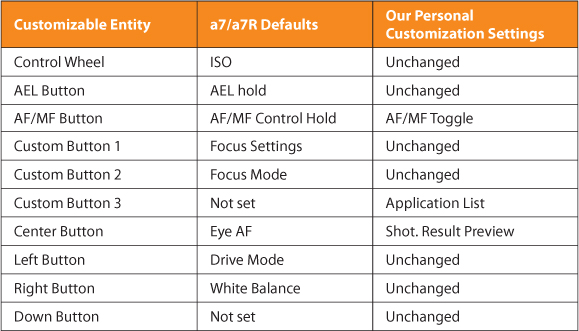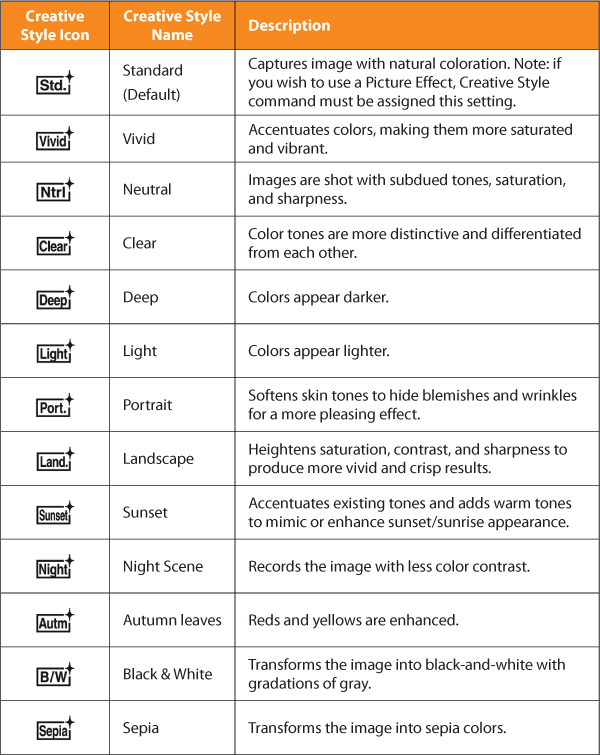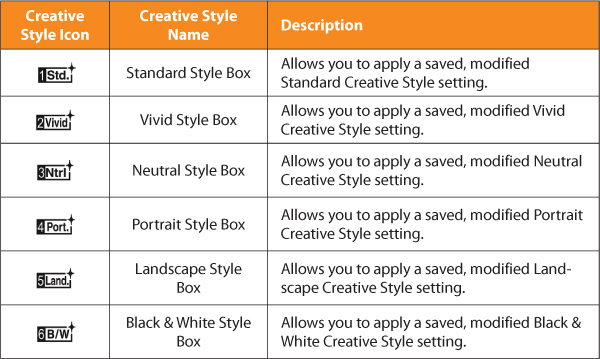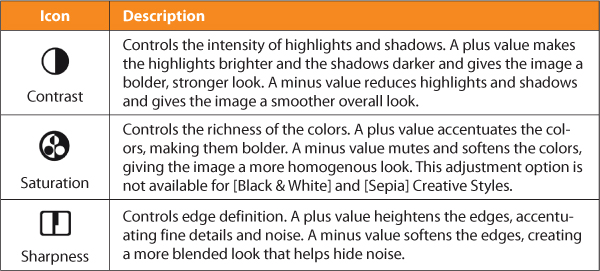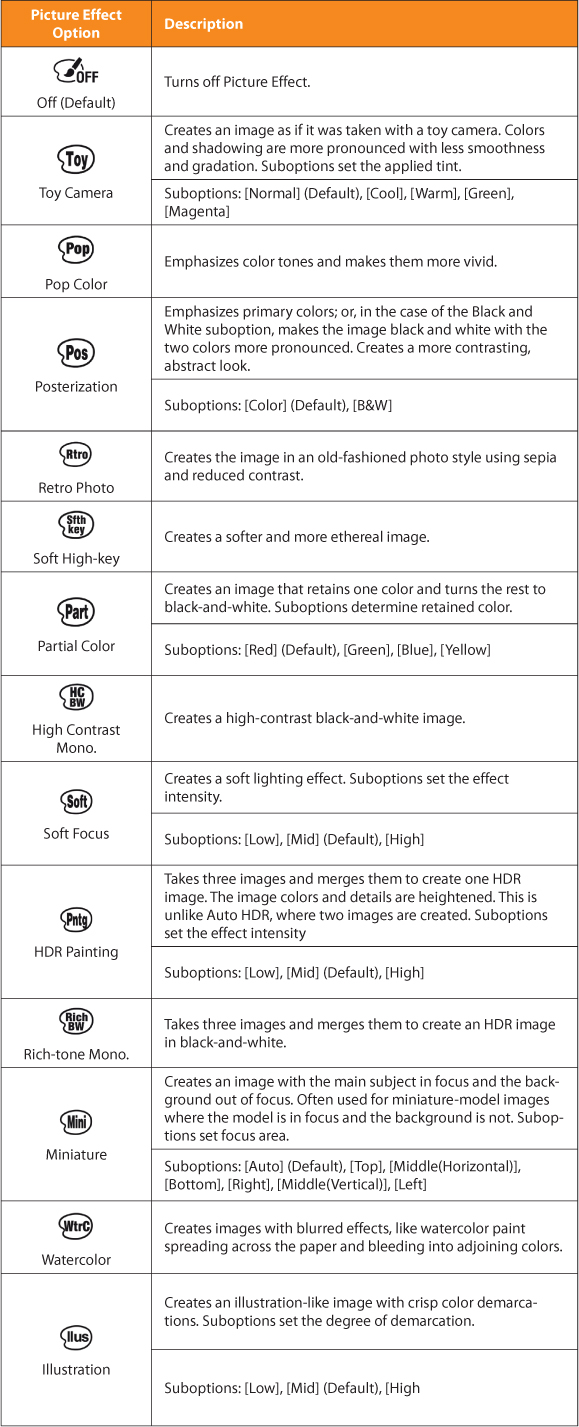Chapter 7: Additional Features

Introduction
The Sony a7/a7R has a wide range of additional features that enable you to set your camera quickly and to add style and uniqueness to your images. In this chapter we will cover both camera customization and additional features that will allow you to enhance your pictures.
Customizing you camera provides you quick access to the settings you need most frequently, making your photography session more efficient and enjoyable. Sony has included numerous customization capabilities in the a7/a7R cameras. Not only can you store three sets of camera commands in the memory, you can also assign a function to one of the many customizable buttons instead of searching through the menu structure to find a specific command. You will realize your needs as you use your camera, and set up your preferences to accommodate your shooting style.
As a new user, you can control whether help information is available for display as you navigate through the structure. In addition, the Sony a7/a7R has many exciting features that give you the opportunity to capture unique pictures. Normally, applying these techniques requires downloading the images to a computer and using post-processing software. Now you can carry out these techniques within the camera. You can use a compositional effect to enhance your final photograph. This can be a simple intensification of the colors or removing the colors entirely and converting the photograph to a black-and-white picture.
All of these features will allow you to tailor your camera’s operations to suit your needs and save you time. How you customize your camera will depend on how you use the camera’s features, your flexibility in learning shortcuts, and your patience in navigating through the menu structure. If you are just starting to use the a7/a7R, we recommend that you limit your modification of its controls. Change your button assignments gradually as you develop a photographic style and a preference for the subjects you photograph. As you gain experience and enjoyment from using your camera, the customization of your camera will happen organically.
In this chapter, we will also cover the remaining still picture shooting modes on the mode dial, Sweep Panorama, Memory Recall 1 and 2, plus two features that affect the image’s color and style: Picture Effect and Creative Style. These two features offer you an opportunity to capture a special image that would have been difficult and time-consuming to create with more conventional photographic methods. We will also cover the a7/a7R’s Auto Obj. Framing. When the camera detects a face or a tracked object, the Auto Obj. Framing function will automatically resize the captured image so that the subject is centered and enlarged to fill the frame when the shutter button is pressed.
Customizing Buttons
There are eleven buttons that can be customized for executing menu commands. How they are customized is controlled by two commands in the Setup menu: Function Menu Set. and Custom Key Settings. Combined, these two commands control 22 menu command customization opportunities that can be assigned to the eleven buttons. Without some customizing, you may find yourself constantly returning to the menu and navigating through its structure to find a specific command for setting a new value.
Fn (Function) Button
The Fn button (figure 7-1) is right above the control wheel on the back of the camera. Its collection of commands is controlled by the Function Menu Set. command. In its default configuration, pressing the Fn button shows twelve command icons, which appear as two rows of six commands each, displayed along the bottom of the screen. When their icons are highlighted, a descriptive text appears in the view screen. There are two ways to navigate through the displayed commands. If you only want to change one command value, navigate to the specific command icon and press the control wheel’s center button. The rest of the Fn button commands will disappear, and only the selected command’s options will be displayed. Make your changes and accept them, and you will be returned to Live View.
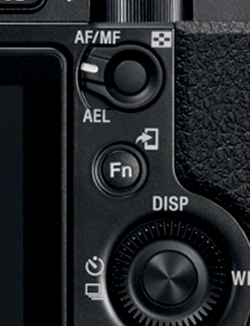
If you wish to make more than one command change, select your icon with the right, left, up, and down buttons. When you rotate the control wheel, you will see a set of changing options appear in the screen. If one or more of the options have a submenu, such as DRO/Auto HDR, you will see icons at the bottom of the screen indicating that you should use the front or rear dial to enter into the submenu and select an option. Once you have found your option, return to the Fn row by pressing the MENU button. Repeat selecting new icons with the directional buttons, and then press the control wheel’s center button to save your changes. Several of the commands, such as WB, Creative Styles, and Focus Area, have submenus that cannot be entered via this method. It is best to make changes to those commands either through the menu or the Fn button by entering the command via the center button.
We have two suggestions for modifying the Fn screen. First, if the control wheel’s rim already accesses commands, such as WB, there is no reason to customize the Fn button to access the same command. Second, keep in mind that each time the camera is reset to the factory defaults through Setting Reset’s [Initialize] function, the Fn button commands return to their default assignments. Because of this, when you customize the Fn button, you should write down your custom settings in case you need to reinitialize the camera.
Setting the Fn Button
To change the Fn button values, use the following command (figure 7-2a-and 7-2b):
MENU>Custom Settings (6)>Function Menu Set.>[Function Upper1], [Function Upper2], [Function Upper3], [Function Upper4], [Function Upper5], [Function Upper6],[Function Lower1], [Function Lower2], [Function Lower3], [Function Lower4], [Function Lower5], [Function Lower6]
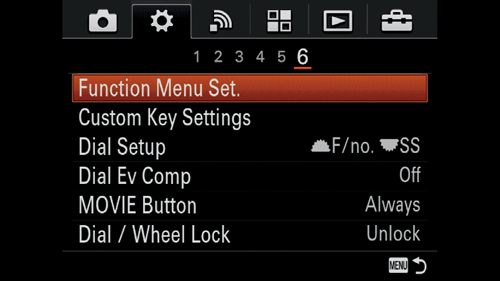
Figure 7-2a: Function Menu Set. command

Figure 7-2b: Function Menu Set. command’s page 1 options
Below is a list of the available options. Each of the Function Menu Set. commands have the same available options.
Drive Mode
Flash Mode
Flash Comp.
Focus Mode
Focus Area
Exposure Comp.
ISO
Metering Mode
White Balance
DRO/Auto HDR
Creative Style
Shoot Mode
Picture Effect
Lock-on AF
Smile/Face Detect.
![]() Soft Skin Effect
Soft Skin Effect
![]() Auto Obj. Framing
Auto Obj. Framing
![]() Image Size
Image Size
![]() Aspect Ratio
Aspect Ratio
![]() Quality
Quality
SteadyShot
Audio Rec Level
Zebra
Grid Line
Audio Level Display
Peaking Level
Peaking Color
Not Set
Table 7-1 contains the camera’s defaults and our personal Fn button’s settings. Remember, our way of customizing the Fn button may not work for the type of pictures you take. You may find that you need to change one or more of the settings because you utilize a different command more frequently for one shooting style, such as shooting portraits indoors, than you do when you are shooting outdoor daytime landscapes.
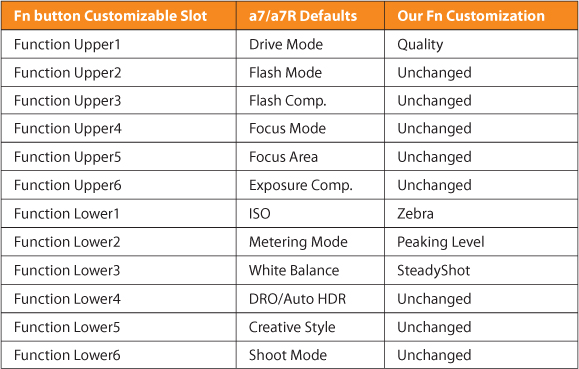
Table 7-1: Default Fn button settings and our typical customization settings
Setting one of the Function Menu Set commands to the [Not set] value voids the slot and no command icon will display in that position along the bottom of the display screen (figure 7-3). Keep in mind that not all commands will be enabled depending on the camera’s shooting mode and other camera menu settings. For example, if Picture Effect command is assigned to one of the Fn button fields, the command icon will be disabled (grayed out) if Quality command is set to [RAW] or [RAW & JPEG]. As you navigate the Fn icons, you will automatically skip over any disabled icons and slots set to the [Not set] option.
When you assign either Exposure Comp. or Shoot Mode to the Fn button, these options work a bit differently than they do when you navigate to their corresponding commands in the camera’s menu. When the Shoot Mode option is assigned to the Fn button, it covers three menu functions: Auto mode, where you can select either Intelligent Auto or Superior Auto; SCN selection, where you can select one of the 9 predefined scene option; and Movie mode, where you can select P, A, S or M mode. The Fn button’s Shoot Mode icon is enabled only when the mode dial is set to AUTO, SCN, or Movie mode. In these cases, the mode dial’s selection will be reflected in the assigned Fn box. Highlight the Fn box, press the center button, and the associated mode dial options will be displayed for you to select a value. Otherwise, the Shoot Mode Fn button’s assigned box is disabled (the mode dial’s selection will be superimposed in the box).
When the Exposure Comp. command is assigned to an Fn button option, the associated Fn box is enabled only when the exposure compensation dial on the top of the camera is set to zero. Otherwise the dial’s non-zero exposure compensation value will be grayed out in the associated Fn box. Keep in mind that the exposure compensation dial has a smaller range, +/- 3 EV, than the Exposure Comp. menu option which is +/- 5 EV. The Fn button option will use the menu’s Exposure Comp. command, therefore allowing you to vary the exposure up to +/- 2 EV more than the corresponding dial.
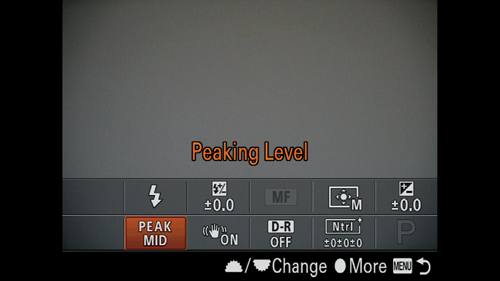
Figure 7-3: Function menu with disabled and not set options
Customization of Other Buttons and the Control Wheel
In addition to customizing the Fn button, you can further modify your camera by assigning functions to ten additional buttons and wheels (figures 7-4a, b, and c).
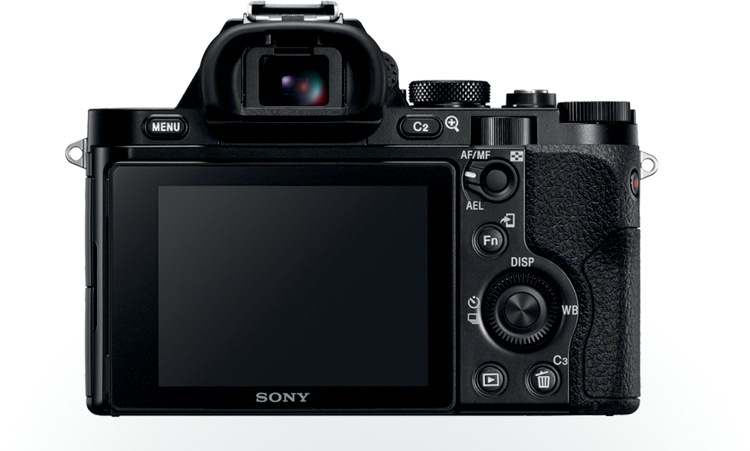
Figure 7-4a: Back of camera body with customizable C2 and C3 buttons, AEL and AF/MF buttons, the center, up, down, right, and left buttons, the control wheel, and the rear dial
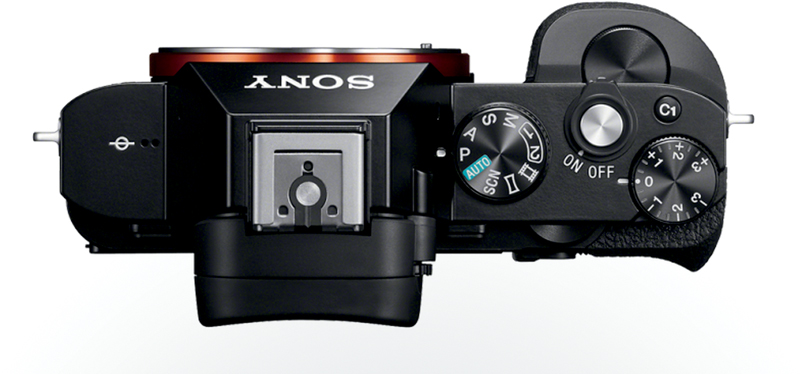
Figure 7-4b: Top of camera body with customizable C1 button and front dial
These customization buttons and wheels are set through the Custom Key Settings command (figure 7-5a and b):
MENU>Custom Settings (6)>Custom Key Setting>[Control Wheel], [AEL Button], [AF/MF Button], [Custom Button1], [Custom Button2], [Custom Button3], [Center Button], [Left Button], [Right Button], [Down Button]
Some of the customization commands have only a few choices, and others have a large variety of choices to select from. The Control Wheel command has five options to choose from:
MENU>Custom Settings (6)>Custom Key Setting>Control Wheel>[ISO], [White Balance], [Creative Style], [Picture Effect], [Not set]
Most of the command’s settings will have their associated command activated when you rotate the control wheel in Live View. The last option, “Not set,” deactivates the control wheel when it is rotated in Live View.
Technically the AEL and AF/MF buttons are the same button. A lever is used to determine if the button activates the AEL or AF/MF function. When the lever is switched to AEL, the AEL Button command’s setting will be in effect; when the lever is switched to AF/MF, the AF/MF Button command’s setting will be in effect. By default, the AEL button controls how the camera’s recommended exposure will be retained when the button is pressed. The AF/MF button, by default, facilitates switching from automatic focus to manual focus.
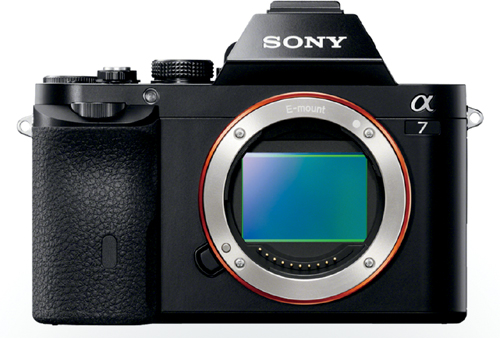
Figure 7-4c: Front of camera body with customizable front wheel
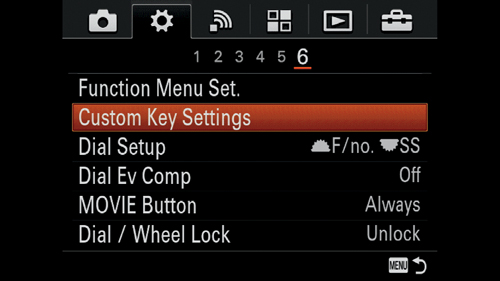
Figure 7-5a: Custom Key Settings command
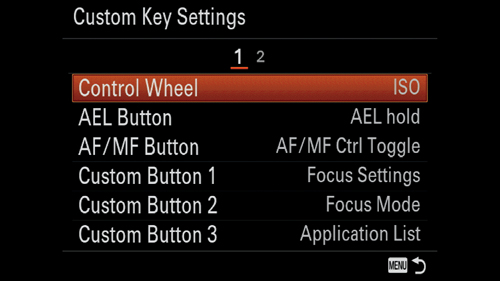
Figure 7-5b: Custom Key Settings command’s page 1 options
If you don’t utilize either the AF/MF or the AEL functionality often, you may wish to customize these two buttons to access more frequently used camera commands. We prefer setting the AF/MF button from [AF/MF Control Hold] to [AF/MF Ctrl Toggle]. We find it cumbersome to continually press the button to maintain the lens in manual Focus Mode. We found that it was too easy to relax our finger pressure while turning the focusing ring and unintentionally turn to automatic focus. By making this button a toggle switch, one press puts you in manual focus. Another press returns you to automatic focus.
You can also customize the three custom buttons (Custom Button1, Custom Button2, and Custom Button3), the Center Button, and the buttons on the rim of the Control Wheel (Left, Right, and Down Button). In addition the rotation of the Control Wheel can be customized to change the White Balance, Creative Style, or Picture Effect. The following list shows the options you have to choose from.
Standard
Drive Mode
Flash Mode
Flash Comp.
Focus Mode
Focus Area
Focus Settings
Exposure Comp.
ISO
Metering Mode
White Balance
DRO/Auto HDR
Creative Style
Picture Effect
Smile/Face Detect.
![]() Soft Skin Effect
Soft Skin Effect
![]() Auto Obj. Framing
Auto Obj. Framing
SteadyShot
Audio Rec Level
![]() Image size
Image size
![]() Aspect Ratio
Aspect Ratio
![]() Quality
Quality
In-Camera Guide
Memory
AEL hold
AEL toggle
![]() AEL hold
AEL hold
![]() AEL toggle
AEL toggle
AF/MF Control Hold
AF/MF Ctrl Toggle
Lock-on AF
Eye AF
AF On
Aperture Preview
Shot. Result Preview
Zoom
Focus Magnifier
Deactivate Monitor
Zebra
Grid Line
Audio Level Display
Peaking Level
Peaking Color
Send to Smartphone
Download Appli.
Application List
Monitor Brightness
Not set
There are a few exceptions. The Standard option is only available for the Center Button command, and the following options are not available for assignment to the Right, Left, and Down Button commands.
AEL hold
![]() AEL hold
AEL hold
AF/MF Control Hold
Eye AF
AF On
Aperture Preview
Shot. Result Preview
Table 7-2: Additional customization default settings and our typical customization settings
Once set, pressing the customized button or wheel will activate the command exactly the same way it would if you had approached it through the menu structure with some exceptions.
Several of the commands do not exist in the camera’s menu: [Standard], [In-Camera Guide], [Deactivate Monitor], [Shot. Result Preview], [Aperture Preview], and [Download Appli.].
Standard Command:
When the center button is set to the [Standard] option, pressing it acts as an Enter button.
In-Camera Guide Command:
If you’re new to Sony cameras, you might want to use the help information that can be displayed about a selected command and its associated options. You can set up the availability to see these descriptions with the [In-Camera Guide] option in the Custom Key Settings command. If you assign this function to one of the customizable buttons or the wheel, every time you view a command or one of its options in the menu, you can press that customized key to view a short informational description about the highlighted command or menu option on the monitor (figure 7-6). It isn’t much information, but it may be sufficient to remind you of the command or the option’s function and how best to use it. Press the customized key again or the MENU button to return to the menu.
Deactivate Monitor Command:
There may be times when the light from the LCD monitor will affect your photograph. Customizing one of your camera’s buttons to function as the Deactivate Monitor option allows you to toggle the LCD monitor on and off. Note that even when the LCD monitor is toggled off using this command, the bottom row of minimal camera settings (shutter speed, aperture, exposure compensation, and ISO) continues to be displayed. The only data display format that does not contain this row is [For viewfinder]. In that case, the Deactivate Monitor displays a completely blank screen.

Figure 7-6: In-Camera Guide’s short description
Aperture Preview Command:
The Aperture Preview command allows you to preview the image with the camera’s aperture physically closed down. When the camera is in P or S mode, the lens aperture is maximally open during live preview. Without this command activated, you would not be able to preview the image’s depth of field, and therefore would not be able to realize how much of the image is in focus until playing back the captured picture. This command is superfluous when shooting in M or A mode, since the lens is stopped down to its working aperture and you have a real-time depth-of-field preview in your viewfinder or on your LCD monitor.
Shot. Result Preview Command:
The Shot. Result Preview is a very useful command. Like the Aperture Preview command, it serves as a depth-of-field preview button when the camera is in P or S mode. When activated, this command shows the effect of the shutter speed and aperture while you are framing the image. For example, when framing a moving object, such as flowing water, Shot. Result Preview will allow you to see the effect of the selected shutter speed while the customized button is depressed. The slower the shutter speed, the more blurred the moving object will look on the display screen. If you want less blurring, you can increase the shutter speed, preview the effect, and take the picture when you are happy with the projected results. The benefit is for you to have an idea of how a moving subject will be captured with the set shutter speed.
Download Appli. Command:
Although you can execute an application through the menu, the Download Appli. command allows you to select a specific application and assign it to a customized key for faster execution. When you set the Download Appli. option to a customized button or wheel, you will be required at that time to select an application to be assigned to the customized key. In our experience, we did not execute downloaded applications frequently enough to make it worthwhile to dedicate a key to this function.
Customizing Front and Rear Dials
You can control which function the front and rear dial executes in Live View by setting the following command:
MENU>Custom Settings (6)>Dial Setup>[![]() SS
SS ![]() F/no.], [
F/no.], [![]() F/no.
F/no.![]() SS]
SS]
(Where “SS” represents the shutter speed and “F/no.” represents the aperture or lens opening.)
Customizing Summary
One way of accessing the camera’s commands is by navigating through the menu structure. This is tedious and impractical for the photographer in the field. For example, to turn on the Creative Style function, you must press the MENU button, navigate to page 4 in the Camera menu, scroll down to Creative Style, and press the center button to enter into the function’s submenu. A faster and more convenient way to get to this command is by assigning it to one of the many customization buttons so you enter the Creative Style’s menu with a press of a button.
Keep in mind that you are not setting an actual value to the specific command; you are only obtaining access to the command options for the purpose of setting a value. Another thing to keep in mind is that the customized buttons and wheels only work when in Live View. For example, the Lock-in AF command uses the center button to assign an object to be tracked. You are not considered to be in Live View at this point since you are actually in the menu activating a command. Once the object has been selected, you are back in Live View and all of the customized button and wheel command assignments will be active.
Should you need to re-initialize your camera back to the factory default values, your customized settings will be lost. We recommend that you keep notes on your customization settings so that if you need to execute the Reset Setting command’s [Initialize] option, you can easily go through the steps to reenter your customization.
Sweep Panorama Mode
The Sony a7/a7R uses the Sweep Panorama mode (figure 7-7) to build a wide view of a scene.
A panoramic picture is created by slowly and smoothly panning (sweeping) a large area horizontally or vertically. The camera takes a series of shots as you sweep. After this is completed, the camera stitches them together to form a panoramic image. There are some conditions to creating a good panorama: the camera needs to be panned at a fairly constant rate—neither too fast nor too slow; you must also sweep on a level horizontal or vertical plane. If there is any substantial variation in the speed or level, the camera will stop shooting and display an error message. This is an excellent opportunity to utilize the Level data display format discussed in Chapter 3.
The camera automatically sets its shutter speed, ISO, and aperture at the beginning of the sweep. These settings remain fixed throughout the recording, so if the lighting conditions change as you sweep the panorama, there may be areas that are under- or overexposed. The variations can cause the results to be unacceptable. Also keep in mind that the camera will not use a shutter speed slower than 1/60 second, so movement of any subject within the image may be captured.
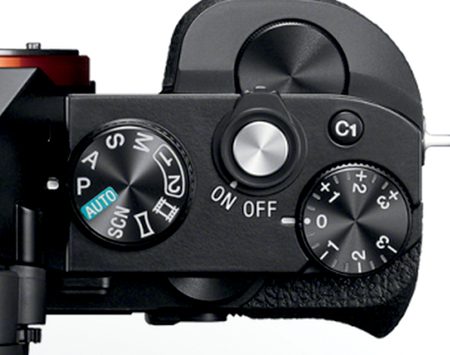
Figure 7-7: Mode dial with Sweep Panorama
The camera does an excellent job of stitching the individual shots to form a wide-frame picture. The software is tolerant of small variations in the sweep rate and the level. Sometimes you can get some intriguing images of moving objects when you sweep in the direction of their travel. For example, if you photograph cars speeding along a road, you may capture them in different areas of the pan so they appear multiple times in the final picture. It’s certainly worth experimenting with this mode.
The camera automatically determines the ISO and the exposure, but you can select a WB and Creative Style option. You cannot use the following commands in the Sweep Panorama mode: Flash Mode, any of the Drive Mode options other than Single Shooting, Picture Effect, Lock-on AF, Smile/Face Detect., Auto Obj. Framing, and DRO/Auto HDR.
As mentioned in Chapter 3, during playback, panorama pictures are displayed in their entirety first. Press the center button to enlarge the image and view the picture sweeping across the screen. There are two ways to enlarge the picture further. First, once Playback mode has been initiated, press the center button to pause, and then press the C2 button with the magnifying icon to enter Magnification mode. You also have the option of enlarging the image after you enter Playback mode (but before you start playing back the picture) by executing the Enlarge Image command:
MENU>Playback (2)>Enlarge Image
With both methods, once you have initially enlarged the image, you can continue to press the C2 button to further magnify. You can also press the right or left buttons of the control wheel to move through the image. In both cases, press the Image Index button to decrease the size of the image or press the center button to exit the magnification view and return to Playback mode.
Sweep Panorama Mode Commands
There are two menu commands associated with panorama shots: Panorama: Size and Panorama: Direction. Both are enabled when the mode dial is set to Sweep Panorama. These commands control the width of the panorama and the direction in which you sweep the camera. To access both of these menu commands, turn the mode dial to Sweep Panorama, press the MENU button, and find the following commands (figure 7-8):
MENU>Camera Settings (1)>Panorama: Size>[Standard], [Wide]
MENU>Camera Settings (1)>Panorama: Direction>[Right], [Left], [Up], [Down]
Sweep Panorama has two sizes: [Standard] and [Wide]. The [Wide] option increases the width of the panorama and increases the pixel count over [Standard] (table 7-3). With [Wide], you can pan farther and get much wider coverage in the resulting picture.

Figure 7-8: Sweep Panorama commands
Table 7-3: Sweep Panorama size
Note that the [Standard] and [Wide] options produce pictures at the same height. Although the [Wide] playback version’s height appears shorter in the LCD screen, it isn’t. Instead, the whole picture is displayed at a lower magnification so you can see more of it on the display screen.
The Panorama: Direction command allows you to set the direction to sweep the camera: [Right], [Left], [Up], or [Down]. Once set, an arrow is displayed on the screen to show the direction to pan. An easier way to set the Panorama: Direction command is to rotate the front dial to cycle through the options while in Live View. Remember to set the mode dial to Sweep Panorama first. You can see the sweep directional arrow on the display screen change with each turn of the front dial. The Sweep Panorama mode works whether you hold the camera in landscape or portrait orientation. Just remember to pan the camera in the direction of the displayed sweep arrow.
Figures 7-9 a-d show Sweep Panorama results for several different combinations of sizes and directions.

Figure 7-9a: Size/Direction = Standard/Right

Figure 7-9b: Size/Direction = Wide/Right
Figure 7-9c: Size/Direction = Standard/Up

Figure 7-9d: Size/Direction = Wide/Up
You can take a panorama picture with either a wide angle or a telephoto lens. Interestingly, you can even zoom the lens in and out during the shooting of a panoramic shot, although it might not be easy to coordinate both sweeping and turning the zoom at the same time while maintaining a smooth, even sweep. If you want to try this and see the effect, we recommend mounting the camera on a tripod to minimize the problem of keeping the camera level.
Shooting a Panoramic Picture
After you select a panorama size and choose the sweep direction, the camera will display three things in Live View:
• An arrow that corresponds with the selected direction
• A message informing you to sweep according to the arrow
• A two-tone screen, in which one side is dull gray over the Live View display and the other side is unaffected (figure 7-10). The line where the two sides meet is the point where the panorama will start.
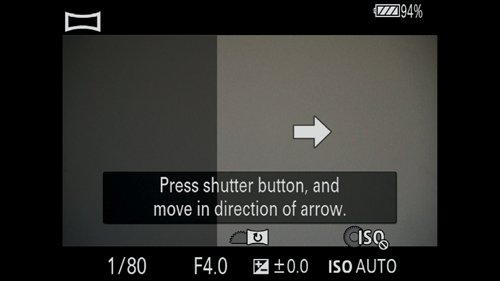
Figure 7-10: Sweep Panorama starting point, to the right of the grayed section. This picture of a piece of paper clearly shows the starting point.
Frame the image so that the point where you wish to start the sweep is positioned just inside the non-grayed side of the display screen. The side that is grayed depends on the panorama direction you select. If you select [Right], the grayed side is on the left in the display screen. If you select [Up], the grayed side is on the bottom of the screen.
This is the time to add a Creative Style and make any needed adjustments to the WB and exposure. Make the changes through the menu, Quick Navi screen, or by pressing the right or the Fn button (if you’ve assigned it to those functions). You can also use the top exposure compensation dial to change the EV value. Make sure you evaluate your adjustments on the non-grayed side since this is where the sweep will start recording. After you complete your adjustments, press the shutter button halfway again to make sure your focus is still intact.
There is one more step to complete before you can take your panoramic shot. Getting a realistic shot depends on a smooth, level, constant sweep. It also depends on creating a very tight radius when you do the sweep. As you pan the camera, hold it as close to the center of the sweep as possible. The best way to accomplish this is to either hold the camera up to your eye and use the viewfinder as your sweeping guide, or mount your camera on a tripod and pan in a vertical or horizontal direction. These two methods are best because they keep the pan in a tight, short radius. Holding the camera away from your body and using the LCD screen as your sweeping guide can create distortion because the shooting radius is larger.
Now you are ready to record. While holding your camera steady, hold the shutter button down and start panning. As you pan, you will notice that the arrow moves across the screen along a simulated bar called the Guidance bar. The bar represents the full amount of time you need to hold the shutter button down and pan the camera. Continue to pan the camera until the arrow has traveled the full distance. If you take your finger off the shutter button while the camera is firing, the process will stop and generate an error message.
Panorama Results
Each panorama has an element of mystery as to what exactly you will capture. Yes, you can end up with a flawless panorama where everything is a true representation of the scene. Most of these are pictures of stationary landscapes. Experiment with taking panoramic pictures of moving subjects. Depending on the subject’s speed, panning in the direction the subject is moving may shorten or truncate it, and panning in the opposite direction may lengthen or elongate it. You can even get results in which a moving object appears multiple times in the photograph. Even taking panoramic pictures of stationary objects can give you some interesting results. When panning, the camera takes images that overlap. Most of the time, the camera’s stitching software eliminates the overlap and creates a smooth panned image, but there will be times when the resulting panoramic picture will contain multiple images of the same object.
Panning Problems
Taking a panoramic image can require some trial and error before you are successful. If the camera detects inconsistent panning—that is, too fast, too slow, or not level—or if you don’t start the panning after the shutter button is pressed, the camera will stop recording and display an error message.
The camera displays the following message if you pan the camera too slow or not in a straight line:
Could not shoot panorama. Move straight in the direction of the arrow.
The camera displays the following message if you pan the camera too fast or in the wrong direction:
Could not shoot panorama. Move camera slowly.
It can be difficult to pan at a consistent speed each time you record. Most likely you will obtain some pictures with a section of gray at the end of the panorama (figure 7-11). This means you panned too quickly, and the remaining portion of the allotted size did not have anything recorded to fill that space. Try retaking the picture while panning a bit slower.
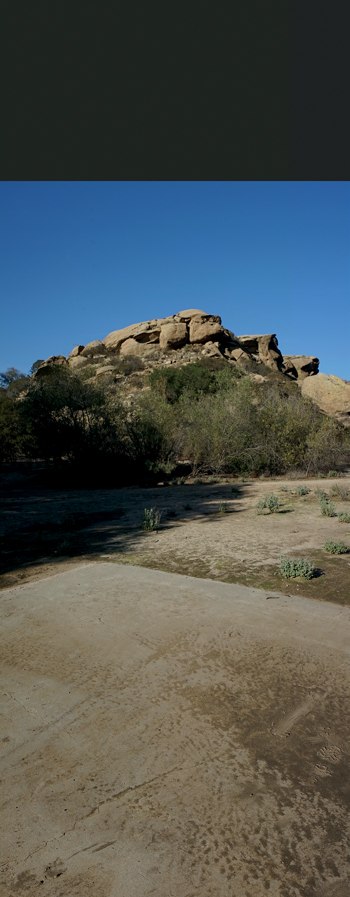
Figure 7-11: Panorama results with unrecorded space grayed out
Your results can also be affected by insufficient or extreme lighting, close or moving objects, complex patterns or monotone colors; all of which cause difficulties for the camera’s stitching program to effectively process the captured data. Keep in mind that the closer the object is, the more likely it is to be distorted, especially if the object consists of straight lines or if you have handheld the camera out away from you while recording the panorama image. Although you might face some frustration, we are sure that, with practice, you will ultimately enjoy the results of the Sweep Panorama function.
Memory Recall Shooting Modes
The mode dial has two additional options, [1] and [2], both representing a set of camera command settings saved in the camera’s internal memory that can be recalled and applied when selected. Making this happen is a multi-step process. First you must establish a set of command values you would like to be able to recall and apply with a turn of the mode dial. Once you have set your camera to those values, save them in the camera’s internal memory using the following command:
MENU>Camera Settings (7)>Memory
Two tabs, 1 and 2, correspond with the two numbers on the mode dial. These will be displayed at the top of the screen, with the camera positioned on the first tab (figure 7-12a). You can also view a list of the commands and their settings for the highlighted memory tab by pressing the up or down button (figure 7-12b).
Press the center button to save the group of settings in the Memory Recall mode corresponding to the tab you are positioned on. To save the other Memory Recall mode, change the command settings to another set of values and re-enter the Memory command. Move to the other tab and press the center button to save the group of values.

Figure 7-12a: Memory command’s full screen with icons and values
To recall and use a group of command settings, rotate the mode dial to the Memory Recall number that contains the settings you want to apply to the camera. That’s all you need to do. You can make adjustments to the applied memory recall settings, but unless you go back and re-enter the Memory command and save the settings, the changes will only be temporary.

Figure 7-12b: Memory command’s list screen with command names and values
Automatic Object Framing
A common beginner’s error is having too much extraneous background in your image that surrounds and detracts from the subject. To improve your picture’s composition, Sony has provided a cropping and resizing function so you can create a more pleasing image. To have the camera automatically create a closer image of your subject, use the following command:
MENU>Camera Settings (6)>Auto Obj. Framing>[Off], [Auto]
For this command to work, the shooting mode and several other command settings must be set properly. If your subject is a person, the Face Detection command must be either set to [On] or [On (Regist. Faces)]. If your intended subject is not a person, you will need to execute the Lock-on AF command and track the object. Regardless of whether your subject is a person or not, there are a few other conditions for Auto Obj. Framing to work. The Quality command must be set to a JPEG value ([Extra Fine], [Fine] or [Standard]), and the Focus Mode must be set to [Continuous AF]. In addition, the Auto Obj. Framing command is enabled only in P, A, S, M, Intelligent and Superior Auto, and all SCN predefined modes except Sports Action, Anti Motion Blur, and Hand-held Twilight. One final condition is that you cannot have the camera set to a multi-shot mode, such as Auto HDR. If these conditions are not met, the Auto Obj. Framing command will be disabled even if it is set to [Auto].
When the Auto Obj. Framing command is enabled and the camera detects and focuses on a face or the tracked object, press the shutter button. The camera will take the picture, enlarge the face or tracked object, and crop and resize the image into either a landscape or a portrait orientation. How the camera orients the cropped and resized image is dependent on the orientation of the double tracking box. If the box is longer vertically, the resulting image is cropped in portrait format; otherwise it is cropped in landscape format.
Auto Obj. Framing functionality records two images; first, the original image as seen on the display screen; and second, the enlarged, cropped image. Keep in mind that if the detected subject is far away, the enlarged image may still be unsatisfactory. If this is the case, it is best to move closer to the subject so you have a better result.
Although you may find that this is a useful tool for taking better pictures, there are several drawbacks. You cannot record the image in RAW file format and therefore will not have full access to your recorded data for future digital enhancements. Using this feature means you will have to accept how much of the original image is enlarged and saved, as well as the exact position. As you become more familiar with the camera, you will be able to frame and take your own portraits without relying on the camera’s automatic feature. Framing the subject, using a zoom lens, controlling the aperture (and thus the depth of field), and saving the image in RAW will let you control many more aspects of your portraits than you can using the Auto Obj. Framing command. While this may be a handy feature for quick snapshots, we suspect most a7/a7R users will prefer to do these same manipulations by downloading the pictures to their computers and using third-party software.
Utilizing Predefined Color Schemes
Although you can post-process your images, the Sony a7/a7R gives you the option to apply a predefined color scheme to your pictures and movies by using the Creative Style or Picture Effect options. This is advantageous because you can see how the altered effect or color scheme will enhance your images before you start recording.
Creative Style Function
Recording a picture or movie can be all about creating a mood or expressing an emotion. An easy way to add expression to your work is to apply a Creative Style to your images. In essence, these styles apply a change in colors and strength to add an emotion into your pictures and movies.
The Creative Style command has 13 different styles or options to choose from (table 7-4a). Each option applies a different mood or style to your movies and pictures, including panoramas. Each Creative Style option has the ability to add fine adjustment values to its applied contrast, saturation, and sharpness, with some exceptions. In addition, six of the Creative Styles options have a way for you to save a second set of customized fine adjustment settings that you can recall later for use (table 7-4b).
Each of these second Creative Style sets are denoted with a number in front of the style’s icon. The icons are so similar that it is easy to get confused and not realize which of the two settings you have selected. With that said, if you like applying Creative Styles to your images and movies, you will appreciate the additional six opportunities to save a different unique setting for the limited Creative Style options. We don’t know why Sony only allows you to save a second set of fine adjustments for those specific six Creative Styles, but it could be that those are the options most commonly used, so being able to save another set of adjustments is more convenient than constantly changing the settings each time you want to apply the Creative Style.
Table 7-4a: Creative Style options and descriptions
Table 7-4b: Second set of customizable Creative Style options and descriptions. Note the preceding number in the icon.
To select a Creative Style, enter the following command:
MENU>Camera Settings (4)>Creative Style
When you select the Creative Style command, the list of options is positioned at the command’s current setting (figure 7-13). Rotate the control wheel or press the up or down button to navigate through the command’s 19 total options. You can also use the front dial.
Although each style’s name gives a hint on how the image will be affected, the only way to be sure is to preview its appearance on the display screen. As you navigate through the Creative Style options, the camera applies the color scheme in Live View so you can evaluate the potential results. For example, applying [Vivid] to a multicolored floral image will have a much different effect than applying it to an image with only one or two colors. In the latter case, you may find a different Creative Style more appealing.
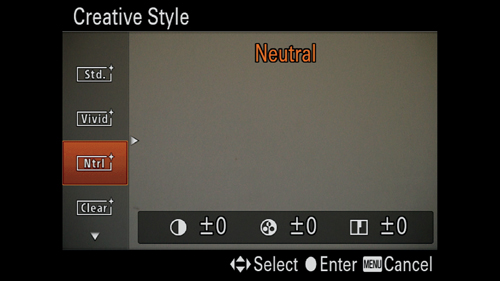
Figure 7-13: Creative Style menu
The command goes a step further and allows you to fine-tune the contrast, saturation, and sharpness (figure 7-14) for all the Creative Style options except [Black & White] and [Sepia], where only the contrast and sharpness can be adjusted.
To enter the fine adjustments menu, highlight the Creative Style option you wish to adjust and press the right or left button or rotate the rear dial to enter into the fine adjustment submenu. Continue to use the right and left buttons or rear dial to move through the fine adjustment options and the up and down buttons to change a specific fine adjustment option’s value. When completed with your settings, press the center button to accept the values. The Creative Style icon along with its fine adjustments will be displayed on the [Display All Info.] and [For viewfinder] data display formats in Live View (figure 7-15).
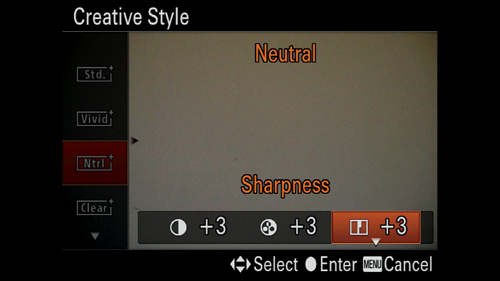
Figure 7-14: Creative Style fine adjustment options each set to +3.
Each fine adjustment has a range from –3 to +3 that changes in increments of 1, which means you can increase or decrease the option by a factor of 1, 2, or 3. Your fine adjustments are retained until you change them or execute the Setting Reset command to return the camera to its Camera Settings default values.

Figure 7-15: Creative Style icon with fine adjustment settings in Live View
The effects of your selected color scheme and fine adjustments are best evaluated on the LCD display screen. Table 7-5 describes each of the available adjustments and their effects on the image.
Table 7-5: Creative Style fine adjustment options
This is where the six customizable Creative Styles options come in. For example, if you typically switch back and forth between two variations of Creative Style [Vivid], you can save both, one in the customizable [Vivid] option and one in the regular [Vivid] option. Both are saved in the camera’s internal memory unless you execute the Setting Reset command. You can even switch to using a Picture Effect or turn off the camera and then come back to Creative Style and still find both of your [Vivid] fine adjustment settings.
Here are some important points to remember:
• The Creative Style command is not available in Intelligent Auto, Superior Auto, or the SCN modes.
• You can set a Creative Style when Quality is set to [RAW] or [RAW & JPEG]. However, you will be constrained by your ability to see these effects depending on the file type you choose and the programs you use to view your images. Image Data Converter shows the Creative Style effects in both RAW and JPEG files. If you use third-party software such as Photoshop or Aperture, the RAW files may not show the effects of the applied Creative Style, but the JPEG files will.
• Creative Styles are available for all movie files.
• While using a Creative Style, you can adjust the exposure compensation, ISO, shutter speed, white balance, and aperture.
• The Creative Style command is automatically set to [Standard] and disabled when a Picture Effect option other than [Off] is selected. The Creative Style command will be enabled and restored to its previous value when Picture Effect is set to [Off].
• Saturation adjustment is not available for the [Black & White] and [Sepia] options.
• Both the regular and customizable Creative Style settings and their adjustments are retained if you switch to another shooting mode, or if the camera is turned off and back on.
• The Creative Style command is reset to [Standard] and all Creative Style adjustments are returned to zero when the MENU>Setup (6)>Setting Reset command is executed.
Picture Effect Function
The Picture Effect function lets you apply a predefined effect filter to be used when recording movies and JPEG picture files. This command is disabled when shooting panorama and when Quality is set to [RAW] or [RAW & JPEG]. There are 14 Picture Effect options (table 7-6). Several of the Picture Effect options have suboptions so you can further alter how you want the camera to record the image. For example, the Toy Camera option has the suboptions [Normal], [Cool], [Warm], [Green], and [Magenta], so you can apply a color tint.
Table 7-6: Picture Effect options
Here are some important points to remember:
• Picture Effects can be applied only when Quality is set to JPEG only files. If Quality is set to [RAW] or [RAW & JPEG] setting, the Picture Effect command is disabled.
• Picture Effect is automatically disabled when the shooting mode is set to Intelligent Auto, Superior Auto, SCN, or Sweep Panorama. It will be returned to its previous value when you switch back to P, S, A, M, or Movie mode.
• The selected Picture Effect and its suboptions are retained when you switch to another supported shooting mode (P, S, A, or M), or if the camera is turned off and back on.
• Picture Effect is reset to [Off] and suboptions are returned to their default values when the MENU>Setup (6)>Setting Reset command is executed.
• While using a Picture Effect, you can adjust the exposure compensation, ISO, shutter speed, white balance, and aperture.
Selecting a Picture Effect is easy. Enter the following command:
MENU>Camera Settings (4)>Picture Effect
Use the control wheel’s rim or the front dial to navigate through the available Picture Effect options (figure 7-16). When you want to apply a suboption, press the right or left button, or rotate the rear dial to navigate through the highlighted Picture Effect suboptions. Press the center button to apply the style’s suboption, and you will be returned to Live View.

Figure 7-16: Picture Effect function’s Soft Focus and suboption icon
An icon is displayed on the [Display All Info.] and [For viewfinder] data display formats in Live View (figure 7-17), indicating the selected Picture Effect and suboption.
Creative Styles and Picture Effects Differences
At first, applying a Picture Effect option might seem like a duplication of Creative Style. However, many of the Picture Effect options allow you to pinpoint areas to apply an effect within the image, such as [Miniature], where you identify an area to keep in focus while blurring the rest of the image. You can use Creative Style options with all Quality settings, but you cannot use Picture Effect options when the Quality is set to capture RAW files. Creative Style and Picture Effect options are not available in automatic modes (Intelligent Auto, Superior Auto, and SCN); however, unlike Picture Effect options, you can use Creative Style options in Sweep Panorama mode.
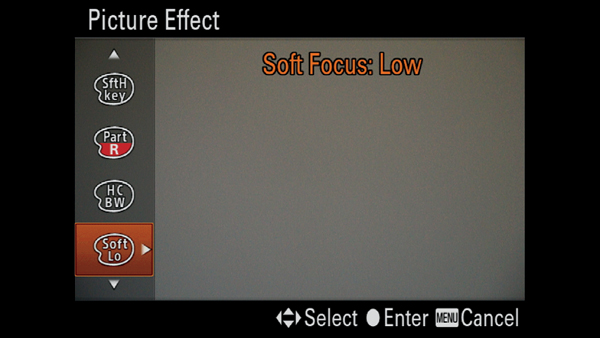
Figure 7-17: Live View with Soft Focus Picture Effect icon and Low suboption
Both the Creative Style and Picture Effect functions colorize images, but the commands cannot be operational at the same time. The Creative Style command is automatically turned to [Standard] when any Picture Effect option is used on the image, and will automatically be turned back to its previous Creative Style setting when Picture Effect is turned [Off]. In other words, each function defaults to a noncompeting value when you set the other to a nonstandard option.
Recommendations
How you customize your camera depends on your personal preferences. We recommend you become familiar with the camera and learn which commands you use frequently before you do any extensive customization. Fortunately, you can always change, add, or subtract your settings later. Once you have selected customizations, the camera will be a more responsive tool, capable of adapting quickly to a variety of photographic requirements.
After we became more comfortable with the camera and what settings we liked, we came up with a set of functions and commands that we use often and want to access easily. Table 7-7 contains the combined list of our settings for each of the customization commands. This may not be how you will want to set things up, and we might change our minds six months from now, but for the types of shots we are currently taking, these settings are working well.
Table 7-7: Our current customization settings
Creative Style and Picture Effect options provide interesting color effects, with some limitations. Although you can modify a Creative Style’s color contrast, saturation, and sharpness through the camera, the allowable range is less than what can be done with post-processing software. When selecting a Picture Effect with a high, mid, and low option setting, start with the high setting first. Quite often the low option setting is too subtle to judge its impact in the camera.
Creative Style allows you to capture the image in both RAW and JPEG formats, which allows you more opportunity to process your pictures outside the camera. Picture Effect allows you to apply expressive filters to your pictures, but only to JPEG files. We recommend that you play with both functions to see if any of the special styles and effects give you results you like. One note of caution: many Creative Style options are subtle. The Picture Effect command has an [Off] option, but the nearest equivalent option for Creative Style is [Standard]; however, be aware that the [Standard] option has adjustments for contrast, saturation, and sharpness. If you don’t want a Creative Style to affect your images, make sure these adjustments are set to zero. Although we enjoy having the opportunity to save two different fine adjustment settings for six of the Creative Styles, we found that the icons are so similar that we sometimes end up choosing the wrong one.
We love panoramic shots. They are fun to shoot, and the results are impressive. We have experimented with many different shots, varied the level and panning speed, and taken shots of moving and stationary subjects, which gives us a variety of results. We’ve taken panoramic shots with the lens fully zoomed, with the lens set to wide-angle, and a variety of settings in between. We have also applied Creative Styles to the panoramic pictures to add some punch to the results.
Using the Auto Obj. Framing command is a quick and easy way to create a closer image of a specific object, but we’ve found that we frequently had to shoot the image multiple times before we were satisfied with the results. We prefer to control the camera settings and frame our shots ourselves in RAW.

